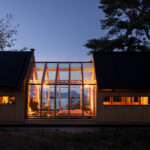The judging process for Architizer's 12th Annual A+Awards is now away. Subscribe to our Awards Newsletter to receive updates about Public Voting, and stay tuned for winners announcements later this spring.
Architecture is, for many reasons, difficult to exhibit. For one thing, architecture is often too large, expensive and fixed in order to be transported and shown around the world like other forms of art. For another, architecture is considered by many to be a quasi-art, something that does not belong alongside paintings and sculptures in museums. Moreover, when architecture is moved into an exhibition space, the very act of movement can transform a structure by removing it from the site or landscape integral to its design.
Yet there are many approaches to exhibiting architecture. Projects are often experienced through primary engagement — historic homes, public pavilions and excavation sites to name a few — thus requiring audiences to seek out architecture and meet it where it stands. Alternatively, designs are typically represented in secondary forms, such as models and photographs, and treated as if equivalent to a work of art meant only for viewing. Each approach is lacking in its own way, and leaves much room for improvement and innovation. The following projects represent some of the ways contemporary architects are rethinking this dilemma, and with it, changing the way the world understands architecture.

© Bio Architecture Formosana

© Bio Architecture Formosana

© Bio Architecture Formosana
AAM Art and Arch Museum by Bio-architecture formosana, Taichung, Taiwan
The Art and Architecture museum in Taichung, Taiwan is a space to contain and exhibit projects, but stands as a captivating display of architecture itself. The building’s rectilinear steel-and-glass structure is augmented on the outside by a fanned arch that primes visitors for the round gallery spaces and sculptural interiors. The museum is anything but a blank white cube.

© Greg Wilson

© Greg Wilson
Center for Architecture Sarasota by Guy Peterson Office for Architecture, Sarasota, Fla., United States
Guy Peterson Office for Architecture renovated a 1960s exhibition space originally designed by William Rupp and Joseph Farrell in Sarasota, Florida. The structure is intended to showcase architecture for a variety of audiences, from established architects to the general public. In the spirit of making the exhibits as accessible as possible, the structure is also designed to be a space for educational programs, so that the gallery can promote future projects as well as current ones.

© SPEECH Tchoban/Kuznetsov

© SPEECH Tchoban/Kuznetsov

© SPEECH Tchoban/Kuznetsov
Museum for Architectural Drawing by SPEECH Tchoban/Kuznetsov, Berlin, Germany
Exhibiting works through a two-dimensional medium, the Museum for Architectural Drawing represents architecture indirectly, in order to make it more accessible. Yet the museum’s design brings this approach full circle, by making the architecture representative of the drawings. Engraved on the structure’s concrete façade are abstracted design drawings that make the building an embodiment of architectural processes.



Paul H. Cocker Architecture Gallery by Gow Hastings Architects, Toronto, Canada
Located inside the campus of Ryerson University in Toronto, the Paul H. Cocker Architecture Gallery reinforces the importance of exhibition spaces in promoting architectural education. The gallery also creates opportunities for students to engage with architecture in a variety of ways, from the traditional critique to curatorial evaluations of the discipline. Galleries can be used to publicize important works of architecture, but they can also be a space of expression and development for architects who do not have the resources to build beyond an exhibition hall.

© Steven Holl Architects

© Steven Holl Architects

© Steven Holl Architects
Nanjing Museum of Art and Architecture by Steven Holl Architects, Nanjing, China
True to its name, the design for the Nanjing Museum of Art and Architecture is inspired by painting as much as it by other buildings. Taking influence from traditional Chinese landscape paintings, the museum’s gallery spaces are designed to resemble landscapes of art and architecture, embracing the sculptural and spatial presence that architecture can command, and the ways in which it can define or recontextualize the surrounding space.

© Bernard Tschumi Architects

© Bernard Tschumi Architects

© Bernard Tschumi Architects
NEW ACROPOLIS MUSEUM by Bernard Tschumi Architects, Athens, Greece
The New Acropolis Museum is designed to accommodate and exhibit one architectural site: the Acropolis in Athens, Greece. The project approaches this historic place through many means of representation, including displays of architectural fragments within its galleries. Yet the museum also inverts traditional relationships between gallery and object by acting as a site for viewing external architecture, including the Parthenon, rather than attempting to contain it.



The Form of Form by Johnston Marklee and Nuno Brandão Costa, Office KGDVS, Lisbon, Portugal; Images © Tiago Casanovs
Built in conjunction with a single exhibition, The Form of Form was designed to host an exploration of architecture conducted by the project Socks Studio. Due to the nature of the collaboration, the structure is not only a space containing the exhibition, but an important part of the exhibition itself. By demonstrating the history of forms represented within the galleries, the structure illustrates how much of a role architecture plays in any exhibit, whether or not architecture is the subject of focus.
The judging process for Architizer's 12th Annual A+Awards is now away. Subscribe to our Awards Newsletter to receive updates about Public Voting, and stay tuned for winners announcements later this spring.









